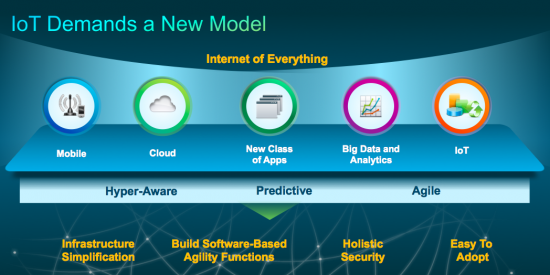































Today the Internet of Things (IoT) is everywhere: you can easily see smart meters on houses, parking sensors in the ground, cameras attached to traffic posts, and people wearing intelligent wristband and glasses -all of them connected to the Internet. And this is only the tip of the iceberg: while you are reading this blog post factories, trains and trucks around the world are also being connected to the Internet.
Many traditional industries have historically requested help from different types of engineers to improve their processes and gain efficiency. Now they are asking us, the Internet engineers, to contribute solving new industrial world challenges by connecting billions of new devices.
The more ambitious part of this journey is the integration between both worlds: Information Technology (IT) and Operation Technology (OT). For that a systems approach is required to scale the existing Internet infrastructure to accommodate IoT use cases, while making IT technology easy to adopt for OT operators. We are facing a historical opportunity to convergence massive scale systems in a way we have never seen before, and such an effort will unlock a multibillion-dollar business.

In order to be ready to capture this opportunity and scale in a sustainable manner, four requirements are necessary:
1. Infrastructure Simplification:Existing Internet infrastructure was originally designed to connect computers, phones, printers, servers and more recently mobile devices mainly operated by users. However, today we are experiencing a tremendous growth not only in the number of devices but also in terms of types of devices, traffic, protocols and locations. These new devices require low bandwidth and run without direct human intervention. Consequently the cost per bits or per user is no longer the only metric, and the infrastructure needs to be redesigned to reduce cost and complexity. This level of flexibility can be achieved by virtualizing and opening up the infrastructure and making it programmable with Cisco Open Network Environment (ONE), which makes it possible to orchestrate services across server, storage, network, and security domains, and provide better service by automating manual tasks, such as configuration and provisioning.
2. Build Software-Based Agility Functions:Deliver new, richer applications and services faster by optimizing the infrastructure with app-centricity and analytics to quickly introduce new capabilities. Keep applications running at peak performance by enabling the infrastructure to automatically detect, and adapt to, application demands and flows, so that it can react to changing conditions and potential issues before they create problems.
3. Holistic Security:Ability to automatically detect and remedy threats is required to enable improved security and compliance in IoT environments. As we built trust models into the E-commerce, these new capabilities need to be combined with access control, context awareness, content inspection, application visibility and threat prevention.
4. Easy to Adopt:In any major technology transition in the past, the adoption curve was driven mainly by fast convergence of standards. Today Cisco's IoT gateways support a very complete IPv6 protocol stack that ensures interoperability across equipment from different vendors. However, the wide diversity of IoT solutions requires even more flexible model where legacy interfaces and protocols can be fully integrated. Cisco IOx offers an open distributed computing platform that is able to scale the IoT to every single scenario, which mean every industry will successfully transition the new era of Internet.
In order to achieve sustainable growth of Internet of Things a systems approach is needed. While in some deployments the scale will mean just adding new connections, in most cases the integration of a legacy system in our current Internet infrastructure will determine our ability to grow. For that we will have to converge by making our infrastructure more elastic, agile and secure, but also by making the technology easy to adopt. By using a hybrid approach where the Internet first meets the extended physical world, we will be able successfully to contribute to solving current world engineering challenges.
For additional information check out my presentation on Scaling the Internet of Things (IoT) at IoT & WSN conference in Europe on Apr 1st, 2014. Also feel free to comment about scalability challenges your organization may be facing in the Internet of Things.
 Tags chauds:
Internet of Everything (IOE)
La virtualisation
Fog computing
évolutivité
business agility
IoT Infrastructure
Open distributed computing
Tags chauds:
Internet of Everything (IOE)
La virtualisation
Fog computing
évolutivité
business agility
IoT Infrastructure
Open distributed computing